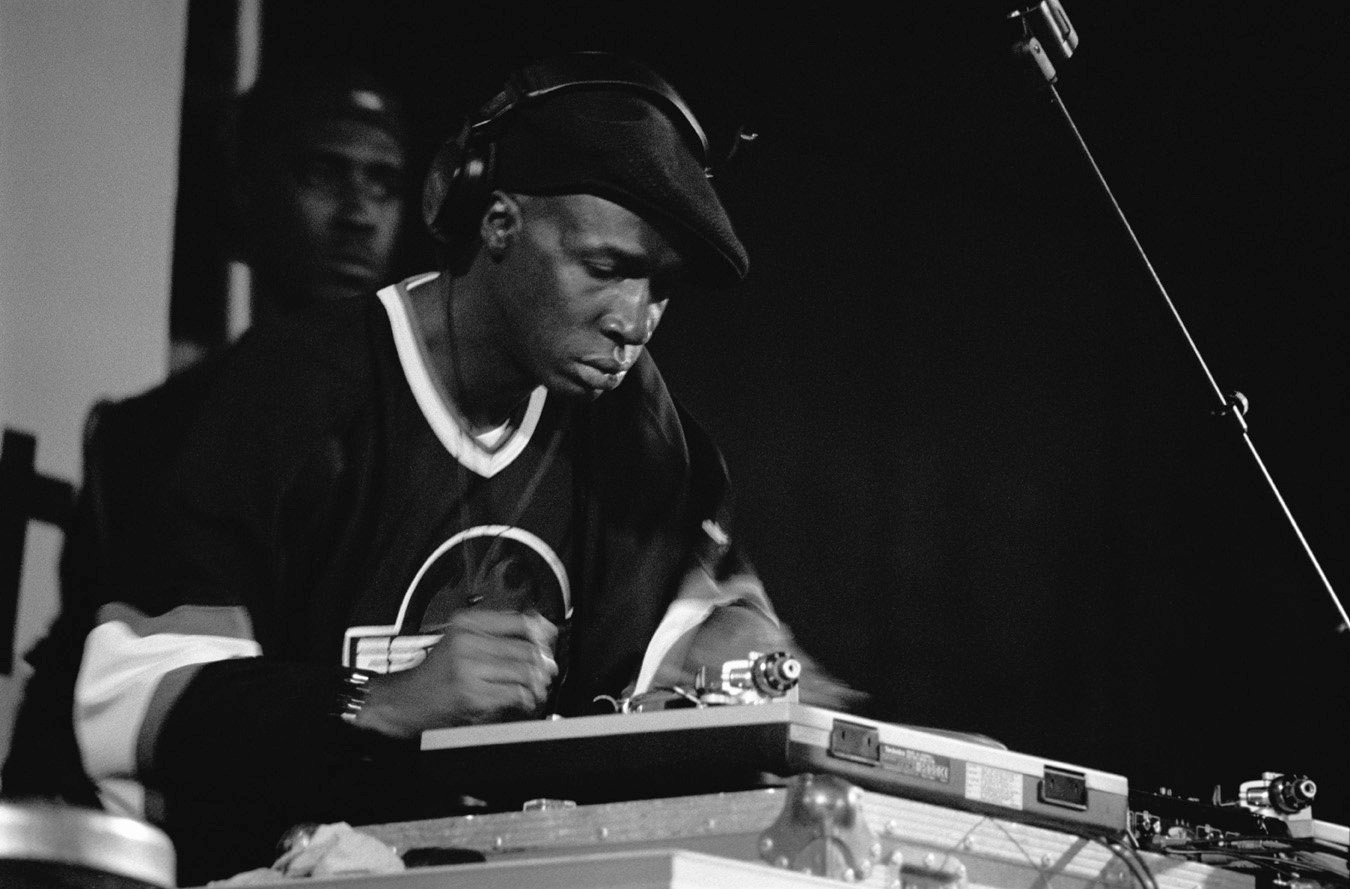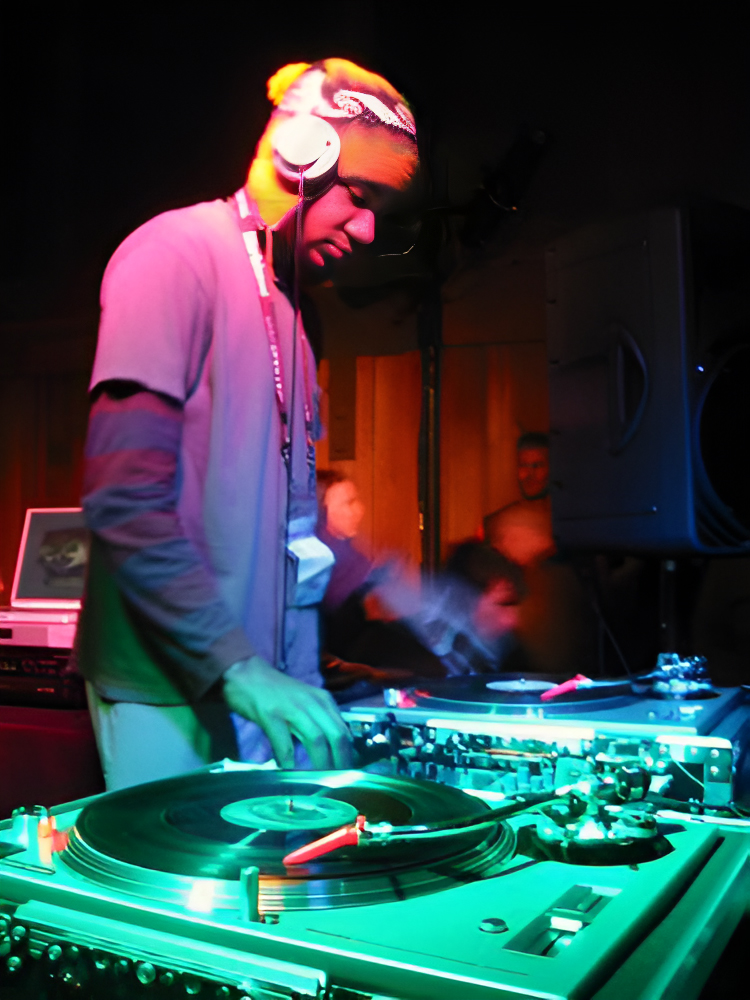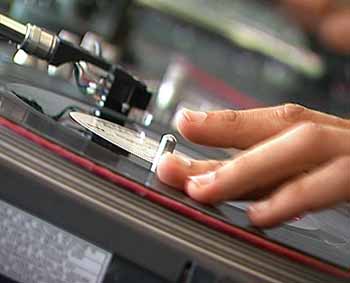|
Slipmat
A slipmat is a circular piece of slippery cloth or synthetic materials disk jockeys place on the turntable platter instead of the traditional rubber mat. Unlike the rubber mat which is made to hold the record firmly in sync with the rotating platter, slipmats are designed to slip on the platter, allowing the DJ to manipulate a record on a turntable while the platter continues to rotate underneath. This is useful for holding a record still for slip-cueing, making minute adjustments during beatmatching and mixing and pulling the record back and forth for scratching. They are also very commonly used simply as decoration for when a record isn't on the turntable. The slipmat was invented by hip-hop pioneer Grandmaster Flash to improve its sound and move the vinyl counterclockwise without causing too much drag and too much friction. In a Washington Post interview, he recalls "My mother was a seamstress so I knew different types of materials," he continues. Having settled on felt, Fl ... [...More Info...] [...Related Items...] OR: [Wikipedia] [Google] [Baidu] |
Grandmaster Flash
Joseph Robert Saddler (born January 1, 1958), known by his stage name Grandmaster Flash, is a Barbadian-American musician and DJ. He created a DJ technique called the Quick Mix Theory. This technique serviced the break-dancer and the rapper by elongating the drum breaks through the use of duplicate copies of vinyl. This technique gave birth to cutting and scratching. It also gave rappers better music with a seamless elongated bed of beats to speak on. He also invented the slipmat. He is the founder and creator of Grandmaster Flash and the Furious Five, the first rap group to be inducted into the Rock and Roll Hall of Fame in 2007. In 2019 he became the first hip hop artist to be honoured with the Polar Music Prize. On May 21, 2022, he acquired an honorary doctorate in Fine Arts from Buffalo State University. On June 1, 2023, he was awarded an honorary doctorate in music from Lehman College in the Bronx, NY. On August 4, 2023, Saddler was issued a proclamation from the city of New ... [...More Info...] [...Related Items...] OR: [Wikipedia] [Google] [Baidu] |
Disk Jockey
A disc jockey, more commonly abbreviated as DJ, is a person who plays recorded music for an audience. Types of DJs include radio DJs (who host programs on music radio stations), club DJs (who work at nightclubs or music festivals), mobile DJs (who are hired to work at public and private events such as weddings, parties, or festivals), and turntablists (who use record players, usually turntables, to manipulate sounds on phonograph records). Originally, the "disc" in "disc jockey" referred to shellac and later vinyl records, but nowadays DJ is used as an all-encompassing term to also describe persons who mix music from other recording media such as cassettes, CDs or digital audio files on a CDJ, controller, or even a laptop. DJs may adopt the title "DJ" in front of their real names, adopted pseudonyms, or stage names. DJs commonly use audio equipment that can play at least two sources of recorded music simultaneously. This enables them to blend tracks together to cre ... [...More Info...] [...Related Items...] OR: [Wikipedia] [Google] [Baidu] |
Slip-cueing
Slip-cueing is a DJ technique for cueing music with turntables. The DJ holds a record still while the platter rotates underneath the slipmat and releases it at the right moment. In this way the record attains the right speed almost immediately, with no need to wait for the heavy platter to accelerate. Slip-cueing was introduced to the disco scene by Francis Grasso, but the technique had been used for many years in the radio broadcast industry; it was often used by radio stations to match a following song to the preceding song, preserving the beat. Grasso used this method to great effect in order to create a continuous flow of music for a nightclub dance floor. See also * Cue (audio) * Needle drop (DJing) * Beatmatching Beatmatching or pitch cue is a DJ technique of pitch shifting or time stretching an upcoming track to match its tempo to that of the currently playing track, and to adjust them such that the beats (and, usually, the bars) are synchronized� ... Sources ... [...More Info...] [...Related Items...] OR: [Wikipedia] [Google] [Baidu] |
Technics SL-1210Mk2
{{disambiguation ...
Technic or Technics may refer to: * Technics (brand), a brand name of the Panasonic Corporation * Technics (law), a legal concept * Technician * Engineering * Lego Technic, toy * An anglicization (with subtle variation) of the Ancient Greek term techne, used primarily in media theory See also * Technical (other) * Technology Technology is the application of Conceptual model, conceptual knowledge to achieve practical goals, especially in a reproducible way. The word ''technology'' can also mean the products resulting from such efforts, including both tangible too ... [...More Info...] [...Related Items...] OR: [Wikipedia] [Google] [Baidu] |
Phonograph
A phonograph, later called a gramophone, and since the 1940s a record player, or more recently a turntable, is a device for the mechanical and analogue reproduction of sound. The sound vibration Waveform, waveforms are recorded as corresponding physical deviations of a helical or spiral groove engraved, etched, incised, or impressed into the surface of a rotating cylinder or disc, called a ''Phonograph record, record''. To recreate the sound, the surface is similarly rotated while a playback #Stylus, stylus traces the groove and is therefore vibrated by it, faintly reproducing the recorded sound. In early acoustic phonographs, the stylus vibrated a Diaphragm (acoustics), diaphragm that produced sound waves coupled to the open air through a flaring Horn loudspeaker, horn, or directly to the listener's ears through stethoscope-type earphones. The phonograph was invented in 1877 by Thomas Edison; its use would rise the following year. Alexander Graham Bell's Volta Laboratory an ... [...More Info...] [...Related Items...] OR: [Wikipedia] [Google] [Baidu] |
Platter (turntable)
Platter may refer to: * ''Platter'' (album), by Jock Cheese * Platter (dinner), a meal of several components served together on a platter or in a basket * Platter (dishware), large dish used for serving food * Platter (horse), American Champion racehorse * Platter, Oklahoma, U.S. * Hard disk drive platter, part of a computer hard drive * A platter lift, a mechanized system for pulling skiers and snowboarders uphill * The Platters, an American vocal group * Platter, a part of a turntable * PLATTER, an acronym for the Planning Tool for Trusted Electronic Repositories developed by Humanities Advanced Technology and Information Institute People with the surname * Bruno Platter (1944–), Grand master of the Teutonic Order * Luanne Platter, fictional character in the animated series ''King of the Hill'' * Thomas Platter (1499–1582), humanist scholar and writer * Thomas Platter the Younger Thomas Platter the Younger (; ; c. 24 July 1574 in Basel – 4 December 1628 in Basel) was ... [...More Info...] [...Related Items...] OR: [Wikipedia] [Google] [Baidu] |
Gramophone Record
A phonograph record (also known as a gramophone record, especially in British English) or a vinyl record (for later varieties only) is an analog sound storage medium in the form of a flat disc with an inscribed, modulated spiral groove. The groove usually starts near the outside edge and ends near the center of the disc. The stored sound information is made audible by playing the record on a phonograph (or "gramophone", "turntable", or "record player"). Records have been produced in different formats with playing times ranging from a few minutes to around 30 minutes per side. For about half a century, the discs were commonly made from shellac and these records typically ran at a rotational speed of 78 rpm, giving it the nickname "78s" ("seventy-eights"). After the 1940s, "vinyl" records made from polyvinyl chloride (PVC) became standard replacing the old 78s and remain so to this day; they have since been produced in various sizes and speeds, most commonly 7-inch discs pla ... [...More Info...] [...Related Items...] OR: [Wikipedia] [Google] [Baidu] |
Phonograph
A phonograph, later called a gramophone, and since the 1940s a record player, or more recently a turntable, is a device for the mechanical and analogue reproduction of sound. The sound vibration Waveform, waveforms are recorded as corresponding physical deviations of a helical or spiral groove engraved, etched, incised, or impressed into the surface of a rotating cylinder or disc, called a ''Phonograph record, record''. To recreate the sound, the surface is similarly rotated while a playback #Stylus, stylus traces the groove and is therefore vibrated by it, faintly reproducing the recorded sound. In early acoustic phonographs, the stylus vibrated a Diaphragm (acoustics), diaphragm that produced sound waves coupled to the open air through a flaring Horn loudspeaker, horn, or directly to the listener's ears through stethoscope-type earphones. The phonograph was invented in 1877 by Thomas Edison; its use would rise the following year. Alexander Graham Bell's Volta Laboratory an ... [...More Info...] [...Related Items...] OR: [Wikipedia] [Google] [Baidu] |
Beatmatching
Beatmatching or pitch cue is a DJ technique of pitch shifting or time stretching an upcoming track to match its tempo to that of the currently playing track, and to adjust them such that the beats (and, usually, the bars) are synchronized—e.g. the kicks and snares in two house records hit at the same time when both records are played simultaneously. Beatmatching is a component of beatmixing which employs beatmatching combined with equalization, attention to phrasing and track selection in an attempt to make a single mix that flows together and has a good structure. Beatmatching is a core technique for DJing electronic dance music, and it is standard practice in clubs to keep a constant beat throughout the night, even if DJs change in the middle. Technique The beatmatching technique consists of the following steps: # While a record is playing, start a second record playing, but only monitored through headphones, not being fed to the main PA system. Use gain (or ' ... [...More Info...] [...Related Items...] OR: [Wikipedia] [Google] [Baidu] |
Scratching
Scratching, sometimes referred to as scrubbing, is a DJ and Turntablism, turntablist technique of moving a vinyl record back and forth on a phonograph, turntable to produce percussive or rhythmic sounds. A crossfader on a DJ mixer may be used to fade between two records simultaneously. While scratching is most associated with Hip-hop, hip hop music, where it emerged in the mid-1970s, from the 1990s it has been used in some styles of Electronic dance music, EDM like techno, trip hop, and house music and rock music such as rap rock, rap metal, rapcore, and nu metal. In Hip-hop culture, hip hop culture, scratching is one of the measures of a DJ's skills. DJs compete in scratching competitions at the DMC World DJ Championships and IDA (International DJ Association), formerly known as International Turntablist Federation, ITF (International Turntablism, Turntablist Federation). At scratching competitions, DJs can use only scratch-oriented gear (turntables, DJ mixer, digital vinyl syste ... [...More Info...] [...Related Items...] OR: [Wikipedia] [Google] [Baidu] |
The Washington Post
''The Washington Post'', locally known as ''The'' ''Post'' and, informally, ''WaPo'' or ''WP'', is an American daily newspaper published in Washington, D.C., the national capital. It is the most widely circulated newspaper in the Washington metropolitan area and has a national audience. As of 2023, the ''Post'' had 130,000 print subscribers and 2.5 million digital subscribers, both of which were the List of newspapers in the United States, third-largest among U.S. newspapers after ''The New York Times'' and ''The Wall Street Journal''. The ''Post'' was founded in 1877. In its early years, it went through several owners and struggled both financially and editorially. In 1933, financier Eugene Meyer (financier), Eugene Meyer purchased it out of bankruptcy and revived its health and reputation; this work was continued by his successors Katharine Graham, Katharine and Phil Graham, Meyer's daughter and son-in-law, respectively, who bought out several rival publications. The ''Post ... [...More Info...] [...Related Items...] OR: [Wikipedia] [Google] [Baidu] |
Hot 97
WQHT (97.1 FM, ''Hot 97'') is a commercial radio station, licensed to New York, New York, which broadcasts an urban contemporary music format. The station is owned by Mediaco Holding, a subsidiary of the Standard General hedge fund. WQHT's studios are located in the Hudson Square neighborhood of Lower Manhattan, and its transmitter is located at the Empire State Building. History WQHT began as an experimental station, W2XWG, licensed to the National Broadcasting Company (NBC) and located at the Empire State Building in New York City. W2XWG started operations in April 1939, initially as an "Apex" station, used for determining the coverage area of transmitting frequencies higher than those used by the standard AM broadcast band."NBC New York FM Station to go to 10,000 Watts" by O. B. ... [...More Info...] [...Related Items...] OR: [Wikipedia] [Google] [Baidu] |





